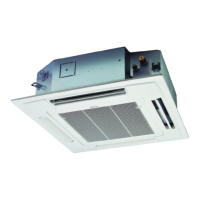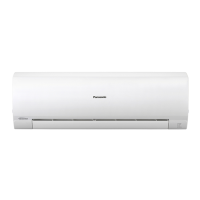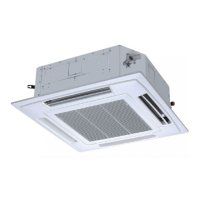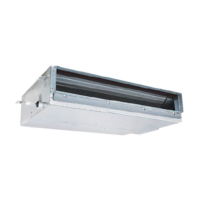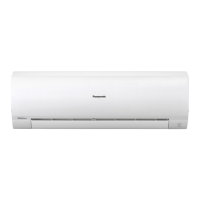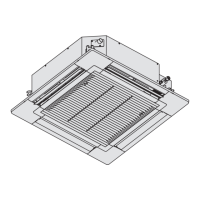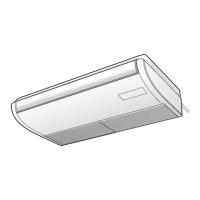Precautions for Installation Using New Refrigerant
1. Care regarding tubing
1-1. Process tubing
● Material: Use C1220 phosphorous deoxidized copper specified in JIS H3300 “Copper and Copper Alloy Seamless Pipes and Tubes.”
For tubes of ø22.22 or larger, use C1220 T-1/2H material or H material, and do not bend the tubes.
● Tubing size: Be sure to use the sizes indicated in the table below.
● Use a tube cutter when cutting the tubing, and be sure to remove any flash. This also applies to distribution joints (optional).
● When bending tubing, use a bending radius that is 4 times the outer diameter of the tubing or larger.
CAUTION
Use sufficient care in handling the tubing. Seal the tubing ends with caps or tape to prevent dirt,
moisture, or other foreign substances from entering. These substances can result in system
malfunction.
Unit: mm
Material O
Copper tube
Outer diameter 6.35 9.52 12.7 15.88 19.05
Wall thickness 0.8 0.8 0.8 1.0 1.2
Unit: mm
Material 1/2 H, H
Copper tube
Outer diameter 22.22 25.4 28.58 31.75 38.1 41.28
Wall thickness 1.0 1.0 1.0 1.1 over 1.35 over 1.45
1-2. Prevent impurities including water, dust and oxide from entering the tubing. Impurities can cause R410A refrigerant deterioration
and compressor defects. Due to the features of the refrigerant and refrigerating machine oil, the prevention of water and other
impurities becomes more important than ever.
2. Be sure to recharge the refrigerant only in liquid form.
2-1. Since R410A is a non-azeotrope, recharging the refrigerant in gas form can lower performance and cause defects in the unit.
2-2. Since refrigerant composition changes and performance decreases when gas leaks, collect the remaining refrigerant and recharge
the required total amount of new refrigerant after fixing the leak.
3. Different tools required
3-1. Tool specifications have been changed due to the characteristics of R410A.
Some tools for R22- and R407C-type refrigerant systems cannot be used.
Item New tool?
R407C tools
compatible
with R410A?
Remarks
Manifold gauge
Manifold gauge Yes No Types of refrigerant, refrigerating machine oil,
and pressure gauge are different.
Charge hose Yes No To resist higher pressure, material must be
changed.
Vacuum pump Yes Yes Use a conventional vacuum pump if it is equipped
with a check valve. If it has no check valve,
purchase and attach a vacuum pump adapter.
Leak detector Yes No Leak detectors for CFC and HCFC that react to
chlorine do not function because R410A contains
no chlorine. Leak detectors for HFC134a can be
used for R410A.
Vacuum pump
Outlet
Inlet
Flaring oil Yes No For systems that use R22, apply mineral oil
(Suniso oil) to the flare nuts on the tubing to
prevent refrigerant leakage. For machines that
use R407C or R410A, apply synthetic oil (ether
oil) to the flare nuts.
* Using tools for R22 and R407C and new tools for R410A together can cause defects.
3-2. Use R410A exclusive cylinder only.
Single-outlet valve
(with siphon tube)
Liquid refrigerant should be
recharged with the cylinder
standing on end as shown.
Valve
Liquid
2WAYEng.indb6 2014/03/1115:03:17
vi
—
CONTENTS
—
Section 1: CONTROL FUNCTIONS-Outdoor Unit .............................. 1-1
1. Introduction ............................................................. 1-2
2. Selecting Outdoor Unit for Operation ......................................... 1-3
3. Compressor Control ...................................................... 1-4
4. Output of PCB .......................................................... 1-11
5. Outdoor Fan Control ..................................................... 1-16
6. Indoor Units Control from the CCU .......................................... 1-19
7. Oil Control ............................................................. 1-22
8. 4-Way Valve Adjustment Control ............................................ 1-26
9. Defrost Control ......................................................... 1-27
10. Upper Current Limitation Mode ............................................. 1-31
11. Alarm Information ....................................................... 1-33
12. Backup Operation ....................................................... 1-37
13. Other Functions ......................................................... 1-41
14. Detailed Settings in EEPROM of Outdoor Unit ................................. 1-44
Section 2: CONTROL FUNCTIONS-Indoor Unit ............................... 2-1
1. Room Temperature Control ................................................. 2-2
2. Heating Standby ......................................................... 2-4
3. Automatic Fan Speed Control ............................................... 2-5
4. Indoor Unit MOV Control ................................................... 2-6
5. Drain Pump Control ...................................................... 2-6
6. Automatic Heating/Cooling Control ........................................... 2-7
7. Discharge Air Temperature Control ........................................... 2-8
8. RAP Valve Kit Control ..................................................... 2-8
9. Automatic Flap Control .................................................... 2-9
10. Filter Sign .............................................................. 2-9
11. Electric Heater Control ................................................... 2-10
12. Fan Control during Dry Mode .............................................. 2-10
13. Ventilation Fan Output .................................................... 2-11
14. T10 Terminal ........................................................... 2-11
15. Parameter ............................................................. 2-12
Section 3: OUTDOOR UNIT REPAIR PROCEDURES ........................... 3-1
1. Removing Panels ......................................................... 3-2
2. Discharging Compressor Oil ................................................ 3-3
3. Backup Operation ........................................................ 3-6
4. Recovering Refrigerant .................................................... 3-8
5. Checking for Leakage After Repair .......................................... 3-15
6. Evacuating System ...................................................... 3-17
7. Charging Compressor Oil ................................................. 3-19
8. Pumping Out Refrigerant from Outdoor Unit ................................... 3-24
9. Compressor ............................................................ 3-27
SM830204-05_2WAY SYS_new.indb 7 15/01/05 11:56:44

